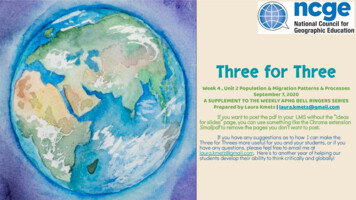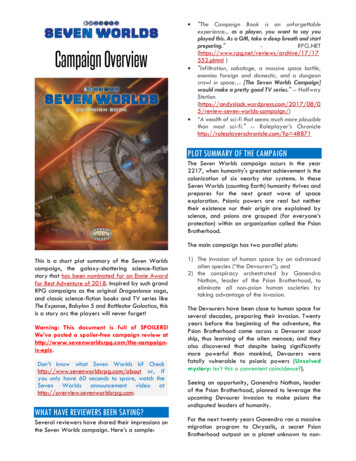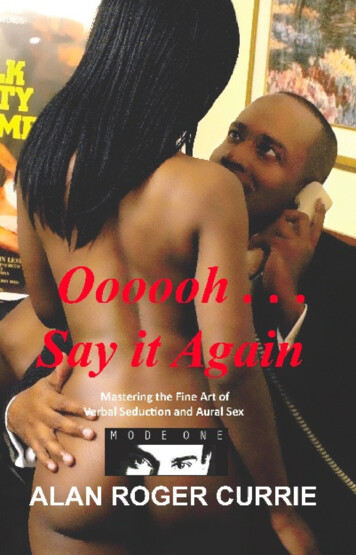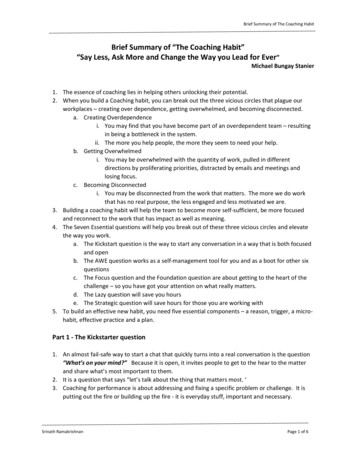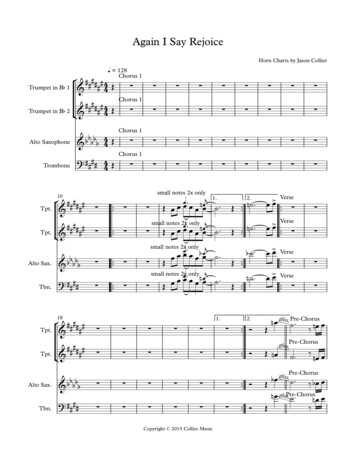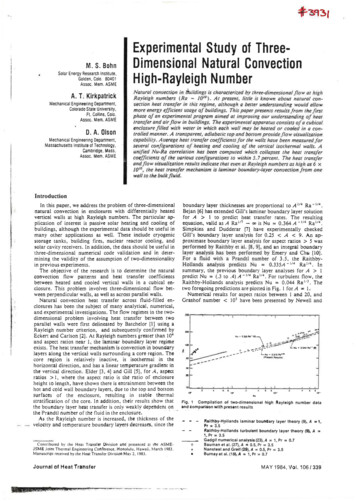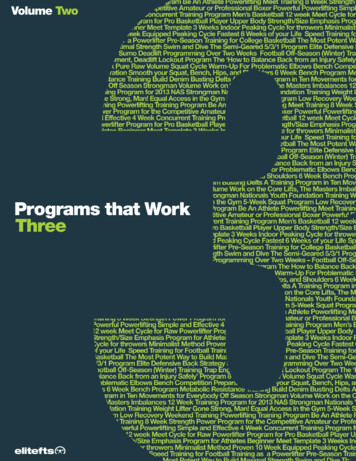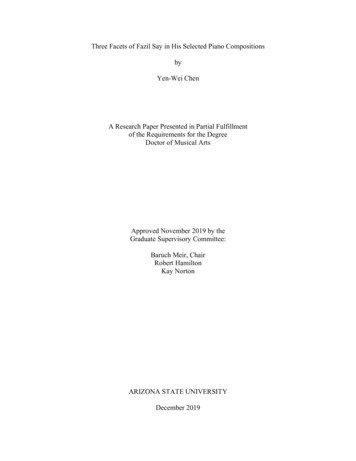
Transcription
Three Facets of Fazil Say in His Selected Piano CompositionsbyYen-Wei ChenA Research Paper Presented in Partial Fulfillmentof the Requirements for the DegreeDoctor of Musical ArtsApproved November 2019 by theGraduate Supervisory Committee:Baruch Meir, ChairRobert HamiltonKay NortonARIZONA STATE UNIVERSITYDecember 2019
2019 Yen-Wei ChenAll Rights Reserved
ABSTRACTBeginning around the 1820s, the refinement of the piano mechanism increased theexpressiveness of the instrument’s sonority and further attracted the composers’ attentionand curiosity about the instrument. Concentration on piano music became a trend forcomposers between the mid to late nineteenth century. During this period, the massiveoutput of music for piano and extremely developed keyboard techniques resulted inclassical composers searching for fresh ideas. Starting in the twentieth century,composers became increasingly interested in music outside the classical world and newinterpretations of meter, harmony, and form. As early as the 1910s, composers includedtone clusters generated at keyboard and soon afterwards, began “playing” the internalcomponents of the piano including strings. Concurrently, they blended different styleswithin a piece according to their cultural and educational background. A prime exampleof this compositional trend is the classically-trained Turkish pianist-composer Fazil Say(b. 1970). His ability as a pianist reflects his strong classical training as well as a stylisticfreedom partly derived from jazz. Say’s inspiration is also drawn from his Turkishheritage, as traditional folk elements have helped to shape his compositions. RepresentingSay’s education, passion, and ethnic background, the three elements of classical, jazz,and folk music have become his primary devices within his solo piano compositions.This brief investigation of Say’s life to date and his piano works offers an insightinto the correlation between the multi-cultural environments in which he has lived andthe formation of his styles. Chapter one, the summary of his life and educationalbackground, illustrates the fact that the three facets within his piano compositions arestrongly rooted in his exposure to different environments. The second chapter presents ai
clear overview of the development of Say’s compositional idiom and a deeper look atselected piano compositions: his transcription of J. S. Bach’s Passacaglia in C Minor,BWV 582, Three Ballads, Black Earth, Alla Turca Jazz, and Paganini Jazz. The goal isto provide current and future pianists with insight into the expressive performance of onecomposer’s extremely successful hybridization of classical, jazz, and Turkish folk music.ii
ACKNOWLEDGMENTSI would like to thank all my doctoral committee members: Professors BaruchMeir, Robert Hamilton, and Kay Norton for all your support as well as the input on mypaper.I would like to express my deepest and sincere gratitude to my teacher andcommittee chair, Dr. Meir, for your inspirational guidance and support during the pastthree years.I would like to thank my friends and colleagues, Scott O’Connor, DeannaRusnock, Gavin Laur, John Solari, Astrid Morales, Chun -Yi Tsang, for providing mewith patience and encouragement throughout the researching process.Last but not least, I would like to thank the members of my family: my parentsMei-Ling Yin and Tung-Ho Chen, for their wise counsel and constant support during mylong journey of learning. This research project would not have been possible withouttheir continued patience and warm love.iii
TABLE OF CONTENTSPageLIST OF EXAMPLES . vLIST OF TABLES. viiCHAPTER1INTRODUCTION . 1Biography . 1Solo Piano Compositions . 5The Compositional Styles . 102A PERFORMANCE GUIDE . 14Transcription of J. S. Bach: Passacaglia in C Minor, BWV 582 . 14Three Ballads. 22Black Earth . 31Alla Turca Jazz . 38Paganini Jazz. 453CONCLUSION . 56REFERENCES . 58APPENDIXAWORKS OF FAZIL SAY THROUGH 2018 . 61BPERMISSION AGREEMENT . 65CAUTOBIOGRAPHICAL STATEMENT . 68iv
LIST OF EXAMPLESExamplePage1.J. S. Bach: Passacaglia in C Minor, BWV 582, mm. 1 – 10 . 182.Fazil Say: Passacaglia, mm. 1 – 4 . 183.Fazil Say: Passacaglia, mm. 8 – 10 . 194.Fazil Say: Passacaglia, mm. 137 – 140 . 205.Fazil Say: Passacaglia, “Fugue,” mm. 168 – 172 . 216.Fazil Say: Three Ballads No. 1 “Nazim,” mm. 1 – 4 . 247.Fazil Say: Three Ballads No. 1 “Nazim,” mm. 29 – 36 . 258.Fazil Say: Three Ballads No. 2 “Kumru,” mm. 1 – 4 . 279.Fazil Say: Three Ballads No. 2 “Kumru,” mm. 16 – 20 . 2710.Turkish Makam, Huseyni Mode . 2911.Fazil Say: Black Earth, A Section . 3312.Fazil Say: Black Earth, A Section . 3413.Fazil Say: Black Earth, B Section. 3514.Fazil Say: Black Earth, C Section. 3615.Fazil Say: Black Earth, B’ Section . 3716.Excerpts from Mozart’s Piano Sonata K. 331, Rondo “Alla Turca” . 3917.Fazil Say: Alla Turca Jazz, mm. 15 – 20 . 4218.Fazil Say: Alla Turca Jazz, mm. 1 – 2, 9 – 10 . 4419.Fazil Say: Paganini Jazz, Var. II, m. 40 . 4620.Fazil Say: Paganini Jazz, “Theme,” mm. 1 – 8. 4821.Fazil Say: Paganini Jazz, Var. II, mm. 37 – 40 . 49v
ExamplePage22.Fazil Say: Paganini Jazz, Var. III, “Superimposition,” mm. 50 – 53 . 5023.Fazil Say: Paganini Jazz, Var. IV, mm. 1 – 3 . 5124.Fazil Say: Paganini Jazz, Var. V, mm. 34 – 39 . 5225.Fazil Say: Paganini Jazz, Var. VI, mm. 53 – 56 . 5326.Fazil Say: Paganini Jazz, Optional Var. II, mm. 7 – 12. 54vi
LIST OF TABLESTablePage1.Fazil Say’s Compositional Period. 52.List of Published Solo Piano Compositions up to 2018 . 73.Structure of Fazil Say’s Transcription of J. S. Bach’s Passacaglia BWV 582 . 164.Comparison of Organ and Piano . 175.Structure of Fazil Say: Three Ballads No. 2 “Kumru”. 266.Structure of Fazil Say: Three Ballads No. 3 “Sevenlere Dair” . 297.Structure of Black Earth. 328.Structure of Fazil Say: Alla Turca Jazz . 41vii
CHAPTER 1INTRODUCTIONI. BiographyBorn in 1970 in Ankara, the capital city of Turkey, Fazil Say grew up in a familyof intellectuals. His grandfather was a mathematician and engineer who received ascholarship to study in Germany. His father, a musicologist who trained in Germany, wasalso a literary scholar who authored several authoritative music encyclopedias as well asbooks on music theory and music history.1 Due to the influences of his family, Say’sremarkable talent in both mathematics and music was fostered at an extremely youngage; by the age of two, he was able to do basic arithmetic as well as play a Mozartmelody on a primitive whistle.2 His family recognized this musical ability and beganproviding him with the finest musical education.Say’s earliest exposure to classical piano training was at the age of three under thetutelage of Mithat Fenmen (1916 – 1982), a famous pianist from Ankara. Fenmen wasone of the first-generation Turkish pianists who studied in Europe with great artists suchas Alfred Cortot (1877 – 1962) and Nadia Boulanger (1887 – 1979).3 Following hisreturn to Turkey, Fenmen established his own pedagogical methods, by incorporatingimprovisation, to teach young Turkish musicians. For example, he encouraged students torely on improvisation rather than the written score at the early stages of learning a piece.4Under Fenmen’s guidance, Say was able to explore more freedom within the music,1Esma Durugönül, “Fazıl Say: A Turkish Musician in Europe,” European Review 24, no. 2 (2016): 455Ahmet Say, “How did Fazil Say Grow Up,” Sol Haber International, October 17, azil-say-nasil-yetisti-1724233Durugönül, 455.4Ibid., 455.21
expanding his musical imagination. Training with Fenmen not only cultivated Say’simprovisational ability, but also inspired his future interpretations and compositionalstyle. In 1983, at the age of thirteen, Say was admitted to the State Conservatory ofAnkara to study music.5 At the conservatory, he experienced abundant musical resources,studied under renowned scholars, and enhanced his cultural and musical development inboth piano and composition.The year 1986 was a pivotal year for Say as he greatly furthered his education andcareer. In February of that year, Say met the famous composer Aribert Reimann (b. 1936)and Reimann’s colleague, American pianist David Levine (1949 – 1993), who werevisiting Ankara as part of a concert tour. After attending Say’s conservatory recital,Reimann exclaimed to Levine “You have to listen to him, this guy plays like a devil.”6 Asa result of their newfound respect for Say’s playing, the two artists invited him to studywith them in Germany. In 1987, he fulfilled his dream and began intensely studyingpiano under the tutelage of David Levine at Robert Schumann Institute of Music inDusseldorf and later at the Berlin Conservatory.7While in Germany, Say grew rapidly as an artist. Moreover, attending concerts byprominent musicians such as Alfred Brendel (b. 1931) and Andras Schiff (b. 1953)helped to broaden his performance perspective and vision. The rich cultural tradition ofEuropean classical music in Germany provided Say with the ability to support his goal ofcultivating a solid historical and theoretical understanding through the examination of5Durugönül, 455.Durugönül, 454.7Fazil Say, “Biography,” Fazil Say Official Website, accessed September 28, 2019,https://fazilsay.com/?page id 2762
first-hand scholarly resources. Starting from the 1930s, the spread of jazz musical culturefrom the United States formed a strong impact on German classical environment andfurther influenced future composers’ musical language.8 Besides the abundant classicalsources in Germany, Say was also interested in the unusual rhythmic structures of jazz,which differed so strongly from traditional German classical music. However, in 1993,his formal music training was interrupted by Levine’s sudden death. The loss of hisbeloved teacher and mentor prompted Say to become his own teacher through readingbooks and scores, as well as attending competitions.Say’s first major success in competition occurred in 1994, when he won theYoung Concerts Artists International Auditions in the United States.9 This victoryprovided him the opportunity to perform in and tour through many American cities.While on one of these tours in 1998, he appeared in New York with Kurt Masur (1927 –2015), conductor of New York Philharmonic. The young pianist received positivereviews from the New York Times due to his highly distinguished performance. This NewYork appearance launched his international career.10 As a guest artist, he performed withdistinguished musicians and spread his musical reputation to countless countries in fivecontinents. In 2002, after a few decades of living abroad, Say made the decision to settle8Kathryn Smith Bowers, “East Meets West: Contributions of Mátyás Seiber to Jazz in Germany,” in Jazz &the Ge
selected piano compositions: his transcription of J. S. Bach’s Passacaglia in C Minor, BWV 582, Three Ballads, Black Earth, Alla Turca Jazz, and Paganini Jazz. The goal is to provide current and future pianists with insight into the expressive performance of one composer’s extremely successful hybridization of classical, jazz, and Turkish folk music. iii ACKNOWLEDGMENTS I would like to .
